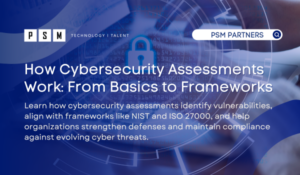Table of Contents
ToggleIn today’s digital era, where technology plays an integral role in our daily lives, it’s no surprise that cyber threats continue to evolve and expand. Did you know that in 2022, cyber-attacks on the Finance and Insurance sectors accounted for nearly 19 percent of the total cyber-attacks worldwide? In fact, it has emerged as one of the foremost targets for cybercriminals, following closely behind the Manufacturing industry. According to these statistics, individuals working in the financial services industry are highly likely to experience a significant and expensive cyberattack at some point. The financial industry’s reliance on digital infrastructure has made it a lucrative target for cybercriminals. Banks, insurance companies, investment firms, and payment processors store vast amounts of sensitive data, including personal information and financial records. These digital repositories of valuable information serve as alluring opportunities for hackers seeking to steal, manipulate, or disrupt financial systems. In order to effectively address these significant challenges, it is crucial to establish a cybersecurity strategy customized to the distinct cyber threats that are widespread within the financial industry. To gain deeper insights into enhancing your company’s cyber resilience and ensuring the security of their infrastructure and data, we are going to explore the most critical cyber threats faced by financial service providers.
Cybersecurity Threats Facing the Financial Industry
Initiating a strong defense begins with understanding prevalent risks and assessing vulnerabilities. Outlined below are significant cyber threats that financial services firms encounter, the potential aftermath of an attack, and approaches to reduce your vulnerability.
- Attacks Involving Social Engineering Techniques
Malicious actors employ social engineering methods to establish trust with their targets. One prevalent social engineering tactic they employ is known as phishing. In 2022, approximately 36 percent of all global phishing attacks were directed at financial institutions. Email phishing is the most common type of phishing, involving the transmission of emails that mimic authentic messages in order to mislead recipients. Engaging with any of the malicious links or attachments in phishing emails often tricks users into providing their credentials to bad actors and might trigger the installation of malware on the targeted computer system. To mitigate the risk of phishing attacks, individuals should receive education on recognizing phishing attempts, regularly update their passwords, implement multifactor authentication, and install both anti-malware and anti-spam protection measures.
- Malware and Ransomware Attacks
Ransomware, which is classified as malware, is a major threat encountered by organizations in the financial sector. According to a report from Sophos, instances of ransomware attacks targeting the financial services sector have risen, with 55% of organizations experiencing such attacks in 2021. Attackers employ various forms of extortion to coerce victims into complying with ransom demands. Regrettably, these extortion techniques are highly effective when directed at financial institutions, given the strict regulations that require exceptional resilience against cyberattacks and data breaches. To reduce the threat of ransomware attacks, it is advisable for individuals to regularly back up their data, set compliance policies and establish an incident response strategy to enhance their overall cybersecurity readiness.
Learn more about Safeguarding Your Data and Network from Ransomware with Microsoft 365
https://www.psmpartners.com/blog/safeguard-your-data/
- DDoS (Distributed Denial of Service) Attacks
The initiation of a DDoS attack commences by compromising several IoT (Internet of Things) devices. DDoS attacks are a common cybersecurity threat targeting financial services due to their extensive attack surface, encompassing banking IT infrastructures, customer accounts, and payment portals. With a successful DDoS attack malicious actors can install malware on each IoT device enabling remote control and subsequent connection to other compromised devices. According to a recent report, there has been a 22% year-over-year surge in the frequency of DDoS attacks targeting financial institutions. To bolster defenses against DDoS attacks, it is crucial to regularly update and patch your protective software, technology, and endpoints, in addition to implementing anti-DDoS hardware and software solutions.
- Supply Chain Attacks
In order to execute a successful supply chain attack, malicious actors target vendors who have inadequate security practices in place. Software supply chains are particularly susceptible to these attacks due to the use of pre-built components such as APIs, proprietary code, and open-source code in the development of present-day applications. In 2022, there was a remarkable 742 percent surge in open-source software (OSS) supply chain attacks when compared year-over-year. The focus of these attacks was to capitalize on vulnerabilities within open-source ecosystems. To mitigate the risk of supply chain attacks, individuals should adopt zero-trust policies and employ endpoint detection and response solutions.
- Cloud Security Threats
Cloud computing provides a more efficient way of managing and storing files, but individuals should remain vigilant regarding potential security threats that can arise. As financial services companies increasingly embrace cloud computing, their security concerns have extended beyond traditional corporate boundaries. Errors in configuring cloud storage or financial applications can inadvertently expose sensitive data. According to a report from Thales, 39 percent of businesses encountered an incident within their cloud environment in the past year. To help mitigate cloud security threats, it’s advisable for individuals to encrypt their data and routinely update their passwords.
Learn more about Prioritizing Security in Microsoft Azure https://www.psmpartners.com/blog/prioritizing-security-in-microsoft-azure/
Securing Your Financial Institution: Ensuring Protection for Your Firm
In an era where data security is paramount, PSM Partners takes cybersecurity for financial services to the next level. We specialize in delivering comprehensive financial IT support and consultant services to a range of financial institutions, including banks, accounting firms, insurance companies, and more. We recognize the critical importance of safeguarding sensitive customer data and ensuring strict security compliance for financial institutions. To achieve this, our professionals conduct a thorough evaluation of your existing security infrastructure and then implement robust, multi-layered security solutions. Our proactive approach is designed to fortify your systems against numerous threats, including malware and data attacks. By partnering with PSM Partners, you can rest assured that your financial institution will benefit from cutting-edge IT support, meticulous cybersecurity measures, and strategic consulting, all aimed at enhancing operational efficiency and safeguarding your sensitive financial data.
You can call PSM Partners at (312) 940-7830 for more about our IT & Cybersecurity support for the financial industry.
Related Insights
What is an SOC Audit?
If your organization handles sensitive data or provides services to...
Read MoreHow Cybersecurity Assessments Work: From Basics to Frameworks
Cybersecurity threats are becoming more sophisticated and widespread, putting sensitive...
Read MoreFuture-Proof Your Technology: Why You Should Consider a Computer Upgrade Every 3 Years
Key Takeaways Three-Year Upgrade Cycle Is Ideal Upgrading business computers...
Read MoreRecovery Time Objective (RTO) vs Recovery Point Objective (RPO): What’s the Difference and Why It Matters for Your Business
Key Takeaways RTO Explained RTO (Recovery Time Objective) is how...
Read MoreAbout the Author

Taylor Friend
I am a dynamic and results-focused Marketing Coordinator at PSM Partners, recognized for my unwavering motivation, meticulous attention to detail, and unwavering commitment to achieving business objectives. Throughout my time at PSM, I have demonstrated remarkable expertise as the primary liaison for Microsoft and NetDocuments, rapidly establishing myself as a proficient point of contact. Additionally, by harnessing my inherent organizational skills, I have effectively elevated the quality of both our internal and external events.





